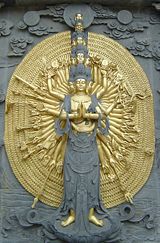Bodhisattva
|
History of Buddhism | |
|
Timeline of Buddhism | |
|
Foundations | |
|
Four Noble Truths | |
|
Key Concepts | |
|
Three marks of existence | |
|
Major Figures | |
|
Gautama Buddha | |
|
Practices and Attainment | |
|
Buddhahood · Bodhisattva | |
|
Regions | |
|
Southeast Asia · East Asia | |
|
Branches | |
|
Theravāda · Mahāyāna | |
|
Texts | |
|
Pali Canon · Mahayana Sutras | |
|
Comparative Studies | |
In Buddhist thought, a bodhisattva (Pali: bodhisatta; Simplified Chinese: 菩萨; Traditional Chinese: 菩薩; pinyin: púsà; Japanese: 菩薩 bosatsu; Korean: 보살 bosal ; Tibetan changchub sempa (byang-chub sems-dpa'); Vietnamese: Bồ Tát) is a being who is dedicated to assisting all sentient beings in achieving complete Buddhahood. Conventionally, the term is applied to hypothetical beings with a high degree of enlightenment. Bodhisattva literally means "enlightenment ('bodhi') truth ('sattva')" in Sanskrit.
Bodhisattvas in Theravada Buddhism
In Theravada Buddhism, the bodhisattva is seen as seeking enlightenment so that, once awakened, he may efficiently aid other beings with the expertise of supreme wisdom. Gautama Buddha's previous life experience as a bodhisattva before Buddhahood are recorded in the texts of the Jataka. Lay Buddhists of Theravada seek inspiration in Gautama's skill as a good layman in these texts, which account not only his historical life, but many previous lives. When Gautama Buddha referred to himself in his pre-Buddha existence, he spoke in terms of "when I was still a Bodhisattva". The only currently active bodhisattva described in the Pali Canon is the future Buddha Maitreya (Pali: Metteyya). The Theravada tradition, i.e., the Pali Canon, speaks of no other bodhisattvas than these.
While the Bodhisatta path is recognized in Theravada Buddhism, it is not seen as a path to be recommended for everyone because of its difficulty and the long time it takes to achieve. The great majority of people are seen to be most fit to practice for enlightenment in this life, as a Sotapanna, Sakadagami, Anagami or Arahant. The option is left open for people to aspire to achieve Paccekabuddhahood or Sammasambuddhahood in a future life, which (according to Theravada doctrine) would mean that suffering would not be extinguished for another 'unmeasurable' period of time (many aeons). The path of the Bodhisatta is not taught in the Pali Canon, possibly because part of becoming a Buddha is discovering this path for oneself.
Bodhisattvas in Mahayana Buddhism
In Mahayana Buddhism, a bodhisattva has the compassionate determination to aid all beings on their quest for the highest state of development, full enlightenment of a Buddha. This type of motivation is known as bodhicitta ('citta' means mind). Remaining in this world of uncontrolled rebirth (samsara), the Bodhisattva has taken the bodhisattva vow to achieve Buddhahood as quickly as possible and thereby be most able to teach Dharma until all beings have likewise achieved enlightenment.
Another common conception of the Bodhisattva is one who delays his own final and complete enlightenment in order to save all sentient beings out of his enormous compassion. He is on a mission to liberate all sentient beings, and only then will he rest and complete his own enlightenment.
In brief, simply imagine the Bodhisattva as saying, "If I know how to swim, and even one other being cannot, then it is right to remain behind in this world to assist them until they know how to save themselves from drowning".
Mahayana Buddhist philosophy sometimes poses the concept of the bodhisattva in opposition to that of the Śrāvakabuddha (conventionally referred to as an Arhat). The Arhat is seen as being liberated from samsara, but he did not choose to save all and every other living being before passing away into Parinirvana, and thus is not a fully enlightened Buddha.
According to many traditions within Mahayana Buddhism, on his or her way to becoming a Buddha, the bodhisattva proceeds through ten, or sometimes fourteen, stages or bhumi. Below is the list of ten bhumis and their descriptions from The Jewel Ornament of Liberation, a treatise by Gampopa, an influential teacher of the Tibetan Kagyu school. Other schools give variant descriptions.
Before a bodhisattva arrives at the first ground, he or she first must travel the first two of the five paths, which are said to correspond to words from the mantra that appears at the end of the Heart Sutra:
- the path of accumulation (gate)
- the path of preparation (gate).
The ten grounds of the bodhisattva then can be grouped into the next three paths
- Bhumi 1 the path of insight (paragate)
- Bhumi 2-7 the path of meditation (parasamgate)
- Bhumi 8-10 the path of no more learning (bodhi)
The 10 Grounds of Buddhism
- Great Joy
- It is said that being close to enlightenment and seeing the benefit for all sentient beings, one achieves great joy, hence the name. In this bhumi the bodhisattvas practice all virtues (paramita), but especially emphasizing generosity (dana).
- Stainless
- In accomplishing the second bhumi, the bodhisattva is free from the stains of immorality, therefore, this bhumi is named 'Stainless'. The emphasized virtue is moral discipline (śila).
- Radiant
- The third bhumi is named 'Radiant', because, for a bodhisattva who accomplishes this bhumi, the light of Dharma is said to radiate from the bodhisattva for others. The emphasized virtue is patience (kṣanti).
- Luminous
- This bhumi is called 'luminous', because it is said to be like a radiating light that fully burns that which opposes enlightenment. The emphasized virtue is vigor (virya).
- Very difficult to train
- Bodhisattvas who attain this bhumi strive to help sentient beings attain maturity, and do not become emotionally involved when such beings respond negatively, both of which are difficult to do. The emphasized virtue is meditative concentration (dhyāna).
- Obviously Transcendent
- Gone afar
- Particular emphasis is on the perfection of skillful means, or upaya-kaushalya, to help others.
- Immovable
- The emphasized virtue is aspiration.
- This, the 'Immovable' bhumi, is the bhumi at which one becomes able to choose his place of rebirth.
- Good Discriminating Wisdom
- The emphasized virtue is power.
- Cloud of dharma
- The emphasized virtue is the practice of primordial wisdom.
After the ten bhumis, according to Mahayana Buddhism, one attains complete enlightenment and becomes a Buddha. Various traditions within Buddhism believe in certain specific bodhisattvas. Some bodhisattvas appear across traditions, but due to language barriers may be seen as separate entities. For example, Tibetan Buddhists believe in Chenrezig, who is Avalokitesvara in India, Kuan Yin (other spellings: Guan Yin, Kwan Yin, Quan Yin, some of which may be seen written as a single word) in China, Quan Am in Vietnam, and Kannon (formerly spelt and pronounced: Kwannon) in Japan. A modern bodhisattva for many is the 14th Dalai Lama, considered by many followers of Tibetan Buddhism to be an incarnation of that same bodhisattva, the Bodhisattva of Compassion.
The bodhisattva is a popular subject in Buddhist art.
The place of a bodhisattva's earthly deeds, such as the achievement of enlightenment or the acts of dharma, is known as a bodhimanda, and may be a site of pilgrimage. Many temples and monasteries are famous as bodhimandas; for instance, the island of Putuoshan, located off the coast of Ningbo, is venerated by Chinese Buddhists as the bodhimanda of Avalokitesvara. Perhaps the most famous bodhimanda of all is the bodhi tree under which Shakyamuni achieved buddhahood.
Bodhisattva in popular culture
- Jack Kerouac mentions Bodhisattva in The Dharma Bums several times. In the book, Japhy Ryder (Gary Snyder) tells Ray Smith (Kerouac) that he (Ray) is a Bodhisattva, a great wise being or great wise angel. Kerouac uses the term several times in the novel, to describe himself and fellow zen Buddhists.
- The band Steely Dan has a song entitled Bodhisattva on their 1973 album Countdown to Ecstasy.
- The Brian Setzer Orchestra covered Steely Dan's Bodhisattva for the soundtrack of Me, Myself and Irene.
- The rap group The Beastie Boys has a song called Bodhisattva Vow on their album Ill Communication.
- Patrick Swayze's character in Point Break is named Bodhisattva.
- The Holy Barbarians have a song called Bodhisattva on the Cream CD.
- In the manga/anime titled Gensoumaden Saiyuki, the bodhisattva called Kannon appears as a minor, but still relevant, character. In this unorthodox take on Buddhism, Kanzeon Bosatsu (a more formal form of Kannon) is a smart-talking hermaphrodite who guides the Sanzo-ikkou on their quest to Shangri-La.
- On the OST for the anime Hellsing, there is a track titled "Bodhisattva Cathedral."
See also
- Bodhisattva vows
- List of bodhisattvas
- Karuna (compassion in Sanskrit)
- Bodhicharyavatara (A Guide to the Bodhisattva's Way of Life)
- Vegetarianism in Buddhism
ReferencesISBN links support NWE through referral fees
- Gampopa; The Jewel Ornament of Liberation; Snow Lion Publications; ISBN 1-55939-092-1
- White, Kenneth R.; The Role of Bodhicitta in Buddhist Enlightenment: Including a Translation into English of Bodhicitta-sastra, Benkemmitsu-nikyoron, and Sammaya-kaijo; The Edwin Mellen Press, 2005; ISBN 0-88946-050-7
- Lampert, K.; Traditions of Compassion: From Religious Duty to Social Activism. Palgrave-Macmillan; ISBN 1-40398-527-8
External links
- Various versions of the Bodhisattva Vow
- Hundreds of free buddhist talks and huge forum.
- The Bodhisattva Vows as practiced in Tibetan Buddhism
- The Bodhisattva Ideal - Buddhism and the Aesthetics of Selflessness
- The group of Eight Great Bodhisattvas at Candi Mendut
- Thousand-hand Bodhisattva Dance
- What A Bodhisattva Does: Thirty-Seven Practices by Ngulchu Thogme
- Images of Buddha, worldwide submitted photos
Credits
New World Encyclopedia writers and editors rewrote and completed the Wikipedia article in accordance with New World Encyclopedia standards. This article abides by terms of the Creative Commons CC-by-sa 3.0 License (CC-by-sa), which may be used and disseminated with proper attribution. Credit is due under the terms of this license that can reference both the New World Encyclopedia contributors and the selfless volunteer contributors of the Wikimedia Foundation. To cite this article click here for a list of acceptable citing formats.The history of earlier contributions by wikipedians is accessible to researchers here:
The history of this article since it was imported to New World Encyclopedia:
Note: Some restrictions may apply to use of individual images which are separately licensed.


